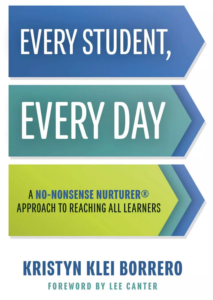A 5th-grade teacher has just started small group instruction in the back of the classroom. He has set the expectation that the remainder of the class is to work in groups of 3-4 to collaboratively develop a solution to two math tasks. As he ushers those in his small group through work that is specific to their learning needs, how does he ensure that his other groups are working productively and with inclusivity?
It is not uncommon to see lower levels of student engagement when the teacher is conducting small groups. Unlike whole group time, there is no focal point, the teacher, standing before the class and continuously watching each student and their level of participation. Similarly, unlike independent work time, where the teacher can circulate and facilitate learning, as small groups are being conducted, there is no teacher taking advantage of proximity to observe and impact student behavior. Small group time does not have to result in chaos and unproductivity in the classroom. There are strategies that:
- Allow teachers to encourage sustained independent work
- Teach students to self-monitor during independent work
- Hold students accountable for productivity
These tactics are neither cumbersome nor time-consuming, yet they have proven very effective in directing and redirecting student behavior.
POSITIVE NARRATION
It has been found that Positive Narration (when delivered using the CT3 Education method) :
- Creates positive momentum
- Repeats the directions Demonstrates caring
- Creates equity by giving all students an equal opportunity to be successful
- Builds relationships with students
- Enhances teacher presence
- Avoids the drawbacks of praise
Tips for implementation:
- Narrate throughout the room as you work in your small group
- Be strategic about who you narrate
- Consider academic narration, where you not only encourage on-task behavior, but specific academic action
- Use a neutral tone to simply notice what a student is doing (Ex. Khem is working at a Voice Level 0 in her anthology)
CREATE CHECKLISTS
When students are given and use checklists they can:
- Have a reminder of each task/step they need to complete during the work period
- Make note of progress as they check items off the list
- Use them as a way to manage time if given a timeframe by which they should have each item on the list complete
Tips for implementation:
- Include information on the checklist that supports a quality work product (Ex. include the use of Spell Check, peer review, comparing work to a rubric)
- Have the students write the checklist in a permanent notebook to be used as a data point regarding their typical level of success at completing tasks
RANDOMLY SELECT STUDENTS TO SHOW THEIR PROGRESS
When students do not know when they may be called upon to show progress toward work completion they:
- Are more likely to remain focused on their work
- Are more likely to seek assistance when they are falling behind on work completion
Tips for implementation:
- Use Equity Sticks to determine who you will call to your small group to quickly show you their progress
- Track student engagement
- Create group incentives to celebrate when students are on track during independent work time (For information on the use of incentives read Every Student, Every Day by Kristyn Klei Borrero
Lastly, and equally important to each strategy above, is providing scholars with precise directions prior to them beginning independent work. The directions should be given only after the teacher has the attention of each student and should not be interrupted by students beginning the task before receiving the full set of instructions. Additionally, the directions should include the voice level at which students may work; the preparation needed to begin the task; the intellectual work to be completed; how long they have to complete the task; and what to do if they finish early. It is also helpful to call on a few students to complete a check for understanding before releasing students to begin the work.
Independent work time is an integral part of any school day. It allows students to demonstrate mastery; provides protective time for introverted students who work most comfortably when working alone; frees the teacher to use their gifts and talents to support individual and small groups of students on targeted goals; and allows students to develop self-determination skills (time management, personal choice, self-accountability). It is worth constructing supports to protect independent work time.
By: Makita Kheperu, Ed.D., CT3 Associate
Check out CT3 Education programs such as No-Nonsense Nurturer, Real Time Teacher Coaching, and Real Time Leadership Coaching to find out more about Professional Development for Teachers and Leaders, classroom management strategies, and building relationships with students and their families.
Category: Education, No-Nonsense Nurturer, Real Time Leadership Coaching, Real Time Teacher Coaching, Teaching, Tips for Teachers



